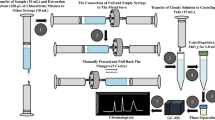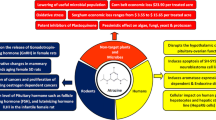Summary
Urinary trans, trans-muconic acid (t,t-MA), a minor metabolite of benzene, is a potential candidate for biological monitoring of benzene. A clean-up procedure using SPE extraction cartridges was applied to urinary samples in order to improve the reliability of t,t-MA determinations by HPLC-UV greatly and to carry out convenient analyses on a routine scale, particularly at low levels of t,t-MA concentrations. The detection limit of the method is low enough to measure urinary t,t-MA at a concentration of 00.05–0.1 mgg/l.The recovery rates and relative standard deviations from spiked urines (1 mg/l to 20 mg/l) were about 90% and 5%, respectively. t,t-MA was found to be rapidly excreted by rats and humans. In rats the background range never exceeded 0.5 mg/l with a mean concentration around 0.3 mg/l. In 49 human blank urines, t,t-MA average and median-value were respectively around 0.2 and < 0.1 mg/l with a range of < 0.1 to 0.5 mg/l. Experimental exposure of rats for 1 h to 10.2 ppm of benzene induced urinary excretion of 13 mg/l of t,t-MA during a 6-h post-exposure period while occupational exposures to 2.6 ppm (mean exposure level during 5d–8 h) and 7 ppm (4 h) of benzene resulted in urinary excretion of 2.1 (mean excretion level) and 6.5 mg/l respectively at the end of the exposure. In humans, t,t-MA has a similar half-time as phenol. Analysis of urinary t,t-MA seems to be a better indicator than phenol for the assessment of exposure to low levels of benzene. Ingestion of 200 mg of sorbic acid, the only other known precursor of t,t-MA, interfered minimally with the background excretion of t,t-MA.
Similar content being viewed by others
References
Cicolella A, Vincent R, Hecht G, Gerber JM (1989) Exposition au benzène dans l'industrie d'extraction des essences naturelles pour la parfumerie. Cah Notes Document 134:99–106
DFG (1985) Benzene derivatives. In: Analyses of hazardous substances in biological materials. Vol 1. Angerer J, Schaller KH (eds). VCH Verlagsgesellschaft mbH, Weinheim, pp 31–56
DFG (1988) Maximale Arbeitsplatzkonzentrationen und Biologische Arbeitsstofftoleranzwerte. Mitteilung XXIV der Senatskommission zur Prüfung gesundheitsschädlicher Arbeitsstoffe, Deutsche Forschungsgemeinschaft
Gad-El Karim MM, Sadagopa Ramanujam VM, Legator MS (1985) trans, trans-Muconic acid, on open-chain urinary metabolite of benzene in mice. Quantification by high-pressure liquid chromatography. Xenobiotica 15:211–220
Gradiski D, Bonnet P, Raoult G, Magadur JL (1978) Toxicité aigüe comparée par inhalation des principaux solvants aliphatiques chlorés. Arch Mal Profess 4–5, 39:249–257
Inoue O, Seiji K, Nakatsuka H, Watababe T, Yin S-N, Li G-L, Cai S-X, Jin C, Ikeda M (1989) Urinary t, t-muconic acid as an indicator of exposure to benzene. Br J Ind Med 46:122–127
Lauwerys (1983) Benzene. In: Human biological monitoring of industrial chemicals series. Alessio L, Berlin A, Roi R, Boni M (eds). Commission of the European Communities. EUR 8476
Medinsky MA, Sabourin PJ, Lucier G, Birnbaum LS, Henderson RF (1989) A physiological model for simulation of benzene metabolism by rats and mice. Toxicol Appl Pharmacol 99:193–206
NIOSH (1985) Method 8305: Phenol and p-cresol in urine. NIOSH Manual of analytical methods, Vol 2:8305-1–8305-4
Stommel P, Müller G, Stücker W, Verkoyen C, Schöbel S, Norpoth K (1989) Determination of S-phenylmercapturie acid in the urine — an improvement in the biological monitoring of benzene exposure. Carcinogenesis 10:279–282
Westöö G (1964) On the metabolism of sorbic acid in the mouse. Acta Chem Scand 18:1373–1378
Author information
Authors and Affiliations
Rights and permissions
About this article
Cite this article
Ducos, P., Gaudin, R., Robert, A. et al. Improvement in HPLC analysis of urinary trans, trans-muconic acid, a promising substitute for phenol in the assessment of benzene exposure. Int. Arch Occup Environ Heath 62, 529–534 (1990). https://doi.org/10.1007/BF00381185
Received:
Accepted:
Issue Date:
DOI: https://doi.org/10.1007/BF00381185




